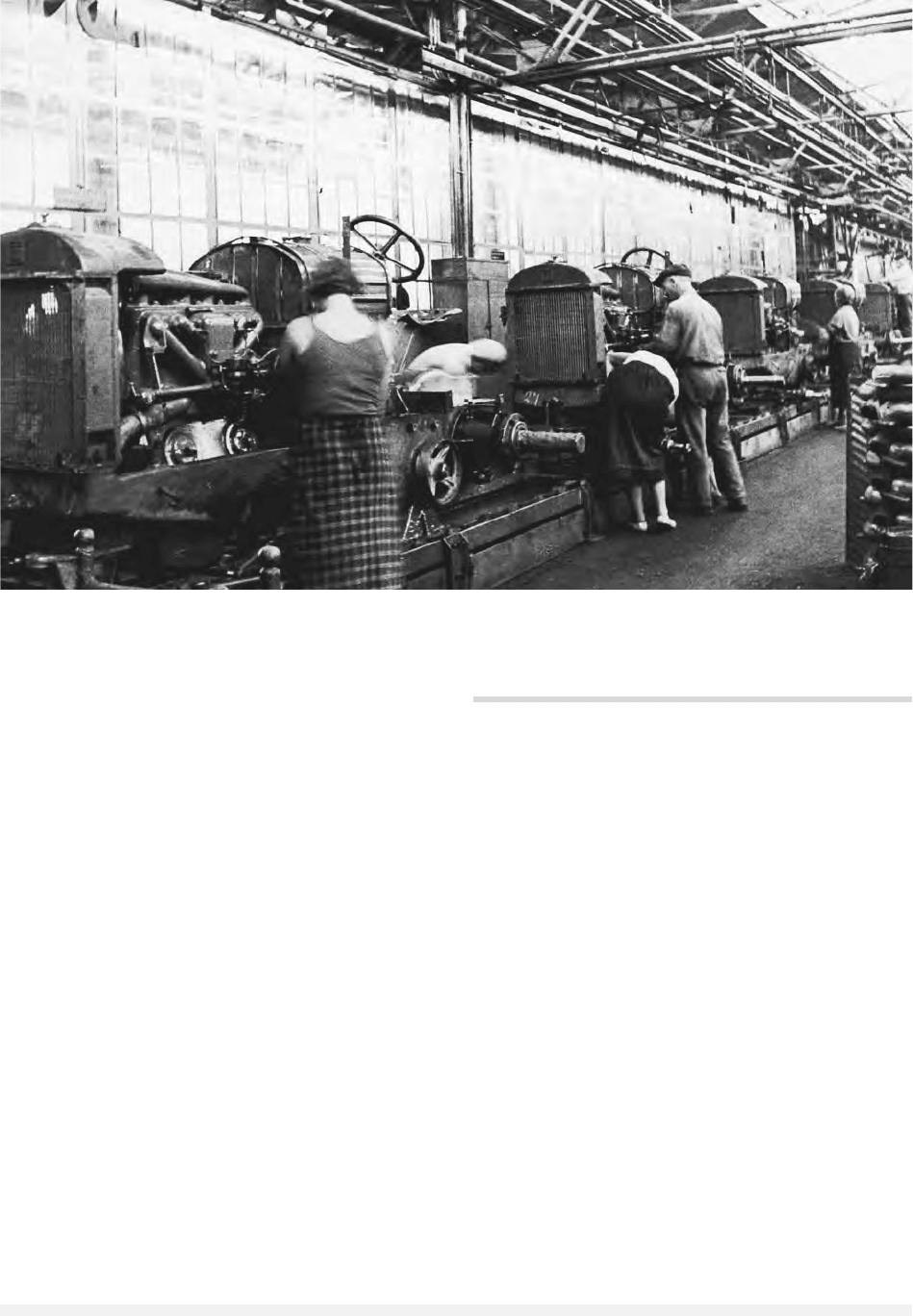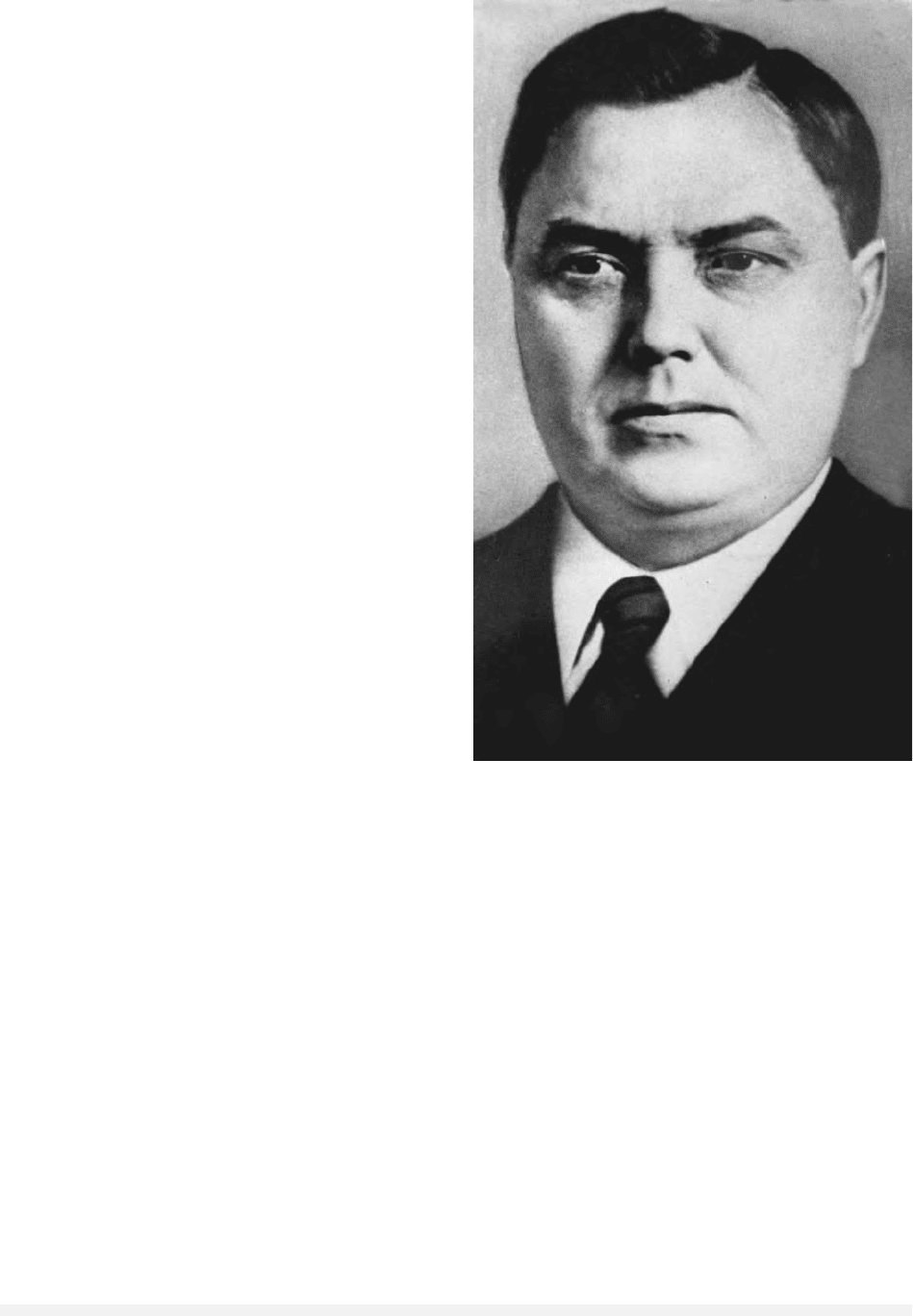Encyclopedia of Russian History
Подождите немного. Документ загружается.


MACARIUS See MAKARY, METROPOLITAN.
MACHINE TRACTOR STATIONS
The Machine Tractor Stations (MTS) were budget-
financed state organizations established in rural ar-
eas of the Soviet Union beginning in 1930. Intended
mainly as a mechanism to provide machinery and
equipment (including repairs and maintenance) to
the kolkhozes (collective farms), they also exerted
state control over agriculture. Payment for the ser-
vices of the Machine Tractor Stations was made in
kind (product) by the farms. The emergence of the
MTS was closely tied to the introduction of the col-
lective farms and especially the continuing debate
over organizational arrangements in the country-
side, notably the appropriate scale or size of the col-
lective farms. The original model of the Machine
Tractor Stations was based upon experimental
arrangements of the Shevchenko sovkhoz (state
farm) in Ukraine. The Machine Tractor Stations
were introduced rapidly. By the end of 1930 there
were approximately 150 Machine Tractor Stations
controlling approximately 7,000 tractors. By 1933
there were 2,900 stations controlling approxi-
mately 123,000 tractors, roughly 50 percent of all
tractors in agriculture, the remaining tractors be-
longing to state farms. Overall, the growth of the
tractor park was rapid, from some 27,000 units in
1928 to 531,000 units in 1940.
The Machine Tractor Stations became the dom-
inant mechanism for providing equipment to the
kolkhozes. While the stations themselves provided
state support to kolkhozes, especially to those pro-
ducing grain, the political departments of the MTS
(the politotdely), established in 1933, became an im-
portant means for exercising political control over
the collective farms. This control extended well be-
yond the allocation and use of machinery and
equipment, and specifically involved the develop-
ment of production plans after the introduction
of compulsory deliveries in 1933. The MTS was,
therefore, an integral part of kolkhoz operations,
and conflict often arose between the two organi-
zations.
The Machine Tractor Stations were abolished
in 1958 during the Khrushchev era. However, their
abolition and short-term replacement with the Re-
pair Tractor Stations (RTS) was in fact a part of a
much more significant process of continuing agri-
cultural reorganization in the 1950s and thereafter.
M
883

In addition to changes within farms during the
1950s, there was continuing emphasis on consol-
idating farms, converting kolkhozes to sovkhozes,
and changing the organizational arrangements
above the level of the individual farms. In effect,
state control came to be exercised through differ-
ent organizations, for example, the Territorial Pro-
duction Associations (TPAs). While the machinery
and equipment were dispersed to individual farms,
in effect the organizational changes in the agricul-
tural sector during the post-Stalin era consisted
largely of agro-industrial integration. The changes
introduced during the 1950s were mainly reforms
of Nikita Khrushchev, and they became a major
factor in Khrushchev’s downfall in 1964.
See also: COLLECTIVE FARM; COLLECTIVIZATION OF AGRI-
CULTURE
BIBLIOGRAPHY
Miller, Robert F. (1970). One Hundred Thousand Tractors:
The MTS and the Development of Controls in Soviet Agri-
culture. Cambridge, MA: Harvard University Press.
R
OBERT
C. S
TUART
MAFIA CAPITALISM
Mafia capitalism is a term that emerged to describe
Russia’s economic system in the 1990s. While the
implied parallel goes to the classic protection rack-
ets of the Sicilian mafia, the actual Russian prac-
tice was different. In order to reflect this, both
scholars and journalists have taken to describing
the Russian system of organized crime as “mafiya.”
There are obvious similarities between mafia
and mafiya, in the form of organized gangs im-
posing tribute on businesses. This is the world of
extortion, hitmen, and violent reprisals against
those who fail to pay up. In the case of mafiya,
however, it mainly affects the small business sec-
tor. Major actors will normally have affiliations
with private security providers that operate a
“cleaner” business of charging fees for protection
against arson and violent assault.
To foreign businesses in particular, the latter
offers plausible deniability in claiming that no
money is being paid to Russian organized crime.
MAFIA CAPITALISM
884
ENCYCLOPEDIA OF RUSSIAN HISTORY
The first tractors coming off the assembly line at the tractor works in Stalingrad. © H
ULTON
A
RCHIVE

Money paid to private security providers, or to of-
ficials “helping out” with customs or other tradi-
tionally “difficult” parts of public administration,
may also frequently be offset against lower pay-
ments of taxes, customs, and other fees.
The real outcome is one where the Russian state
and thus the Russian population at large suffer
great damage. Not only is the government’s tradi-
tional monopoly on violence both privatized and
decentralized into hands that are under no effective
control by the authorities, but money destined to
have been paid to the Russian government ends up
instead in the coffers of security firms.
Moreover, businesses in Russia are subjected to
demands for tribute not only from organized crime
gangs, but also from a broad variety of represen-
tatives of the official bureaucracy. This far exceeds
the corruption associated with mafia in many other
parts of the world, and explains in part why, in
the compilation of international indices on corrup-
tion, Russia tends to rank amongst the worst cases.
Russian entrepreneurs will typically be sub-
jected to several visits per month, maybe even per
week, by representatives of public bodies such as
the fire department or the health inspectorate, all
of which will expect to receive a little on the side.
The burden on the small business sector in par-
ticular should be measured not only in financial
terms, as the tribute paid may be offset by tax
avoidance. Far more serious is the implied tax on
the time of entrepreneurs, which often tends to be
the most precious asset of a small business. The
number of hours that are spent negotiating with
those demanding bribes will have to be taken from
productive efforts.
The overall consequences of mafiya for the
Russian economy are manifested in the stifling of
private initiative and degradation of the moral ba-
sis of conducting business.
See also: CRONY CAPITALISM; ORGANIZED CRIME
BIBLIOGRAPHY
Center for Strategic and International Studies. (1997).
Russian Organized Crime. Washington, DC: Center for
Strategic and International Studies.
Handelman, Stephen. (1995). Comrade Criminal. New
Haven, CT: Yale University Press.
S
TEFAN
H
EDLUND
MAIN POLITICAL DIRECTORATE
Officials from the Communist Party of the Soviet
Union (CPSU) monitored workers in key occupa-
tions to ensure their adherence to party doctrine
and loyalty to the CPSU and the Soviet Union.
In the Soviet army and navy, the CPSU main-
tained a shadow system of command parallel with
the military chain of command. In the early days
of the USSR, Party commanders (politruks) ensured
the political reliability of regular officers and sol-
diers. As the Party became more secure in the po-
litical allegiance of the military, party commanders
became “deputies for political work” (zampolit).
These officers were directly subordinated to the unit
commander, but they had access to higher party
officials through a separate chain of command. By
and large, the zampolit dealt with matters such as
morale, discipline, living conditions, training, and
political indoctrination. Security issues such as po-
litical reliability were the primary concern of the
Special Section. The Main Political Directorate also
scrutinized the content of military publications, in-
cluding the official newspaper Krasnaya zvezda and
military publishing houses.
In the post-Soviet era, military discipline is
handled by the Main Directorate for Indoctrination
Work. Without the power of the Party behind this
institution, problems such as discipline, desertion,
crime, and others have become increasingly more
serious.
See also: COMMUNIST PARTY OF THE SOVIET UNION; MIL-
ITARY, SOVIET AND POST-SOVIET
BIBLIOGRAPHY
Herspring, Dale R. (1990). The Soviet High Command,
1967–1989: Personalities and Politics. Princeton, NJ:
Princeton University Press.
Whiting, Kenneth R. (1978). The Development of the Soviet
Armed Forces, 1917–1977. Maxwell Air Force Base,
AL: Air University Press.
A
NN
E. R
OBERTSON
MAKAROV, STEPAN OSIPOVICH
(1849–1904), naval commander during Russo-
Japanese War; prolific writer on naval affairs.
Vice Admiral Stepan Osipovich Makarov, com-
mander of the Pacific Squadron of the Russian navy
MAKAROV, STEPAN OSIPOVICH
885
ENCYCLOPEDIA OF RUSSIAN HISTORY

during the Russo-Japanese War and the author of
more than fifty works on naval tactics, technol-
ogy, and oceanography, was born in Nikolaevsk
on the Bug River and graduated from naval school
at Nikolaevsk on the Amur in 1865. While still in
school he was deployed with the Pacific Squadron
in 1863, and after graduation he joined the Baltic
Fleet. Serving on the staff of Vice Admiral A.A.
Popov from 1871 to 1876, Makarov was involved
in naval engineering projects, including studies of
problems related to damage control.
During the Russo-Turkish War of 1877–1878,
Makarov commanded the Grand Duke Konstantin
and successfully conducted mine/torpedo warfare
against Turkish units in the Black Sea, using steam
launches armed with towed mines and self-
propelled torpedoes. In 1878 he took part in the
unsuccessful effort to construct a mine-artillery
position to prevent the British Royal Navy from
entering the Turkish Straits and began the devel-
opment of techniques for underway minelaying.
He conducted a major study of the currents in the
Turkish Straits during the late 1870s, commanded
the riverine flotilla that supported General Mikhail
Skobelev’s Akhal-Tekke Campaign in Central Asia
in 1880-1881, commanded the corvette Vityaz on
a round-the-world cruise from 1886 to 1889,
served with the Baltic Fleet during the early 1890s,
and was inspector of naval artillery from 1891 to
1894. During the mid-1890s Makarov completed
another round-the-world cruise. In December 1897
he published his essay “Discussions on Questions
of Naval Tactics.” Makarov wrote extensively on
the impact of technology on naval tactics and was
one of the foremost authorities on mine warfare at
sea. During the late 1890s he directed the con-
struction of the Baltic Fleet’s first icebreaker, the
Ermak. In 1899 he was appointed commander of
the naval base at Kronstadt.
After the Japanese surprise attack in January
1904, Makarov assumed command of the Russian
squadron at Port Arthur, immediately instituting
measures to raise the morale of its crews. On April
13 Makarov ordered a sortie to support Russian de-
stroyers engaged with Japanese vessels. Shortly af-
ter getting under way his flagship, the battleship
Petropavlovsk, struck a mine that detonated the for-
ward magazine. Vice Admiral Makarov died along
with most of the ship’s crew and the painter Vasily
Vereshchagin.
See also: ADMIRALTY; BALTIC FLEET; BLACK SEA FLEET;
RUSSO-JAPANESE WAR; RUSSO-TURKISH WARS
BIBLIOGRAPHY
Makarov, Stepan Osipovich. (1990). “Discussions of
Questions on Naval Tactics.” In Classics of Sea Power,
ed. John B. Hattendorf. Annapolis, MD: Naval In-
stitute Press.
J
ACOB
W. K
IPP
MAKARY, METROPOLITAN
(c. 1482–1563), also known as Macarius; arch-
bishop of Novgorod (1526–1542); metropolitan of
Moscow and all Rus (1542–1563); prominent reli-
gious and political figure of the sixteenth century.
Makary’s parentage is not known, and noth-
ing is known about him before he was tonsured at
the Pafnuty-Borovsk Monastery at the end of the
fifteenth century. In February 1523, Metropolitan
Daniel appointed Makary archimandrite of the
Luzhetsk Monastery near Mozhaisk. He became
archbishop of Novgorod and Pskov on March 4,
1526, the first archbishop to be appointed to that
city since 1508. This appointment may have come
about, at least in part, as a result of Makary’s sup-
port of the divorce of Grand Prince Basil III from
his wife Solomonia in 1525 and the subsequent
marriage of the grand prince to Elena Glinskaya.
As archbishop, Makary undertook reorganization
of the monasteries and promoted missionary ac-
tivity to the Karelo-Finnic population in the north-
ern reaches of his jurisdiction. He also undertook a
number of building and restoration projects, in-
cluding the direction of the unsuccessful construc-
tion of the first water mill on the Volkhov River.
The greater complexity of Novgorodian church ar-
chitecture in the 1530s, such as tri-apse construc-
tions and five-cupola designs, has been attributed
to Makary’s intervention. Makary also undertook
a number of literary and mathematical activities,
including updating the Novgorod Chronicle, com-
piling a menology, which became the prototype of
the Great Menology, and calculating the date of
Easter through the year 2072. In 1531 he partici-
pated in the council that tried the monks Maxim
the Greek, Isaak Sobaka, and Vassian Patrikeyev for
holding heretical views.
Makary replaced Ioasaf (Joseph) as metropoli-
tan of Moscow and all Rus on March 16, 1542,
and took over responsibility for the education and
upbringing of the young Ivan IV. He continued as
a close adviser of the tsar until the end of his own
life. In 1547 Makary presided over the coronation
MAKARY, METROPOLITAN
886
ENCYCLOPEDIA OF RUSSIAN HISTORY

of Ivan as tsar (January), the marriage of Ivan to
Anastasia (February), and (with Ivan) a church
council (January–February) that canonized a num-
ber of Rus saints. Makary was badly injured in the
Moscow fire in June of that year when he was be-
ing lowered from the Kremlin wall to escape the
flames. Nonetheless, he continued to remain active
in religious and political affairs while he recovered.
In February 1549, along with Ivan, he presided over
another church council that canonized more Rus
saints. In June 1550, Makary and Ivan presided
over the assembly that compiled the Sudebnik of
1550, the first major revision of the law code
since 1497. During January and February 1551,
Makary presided with Ivan over the Stoglav (Hun-
dred-Chapter) church council, which codified the
regulations of the Church similar to the way gov-
ernment laws had been codified the previous year
in the Sudebnik. Also in 1551, Makary released
Maxim the Greek from imprisonment and allowed
him to move to the Trinity–St. Sergius Monastery
in Zagorsk but would not allow him to return to
Greece.
While Ivan IV was away on the campaign
against Kazan from June through October 1552,
Makary, along with Ivan’s wife Anastasia and
brother Yuri, was left in charge of running the civil
affairs of the Muscovite state. By 1553, his first
large literary compilation project as metropolitan,
the Great Menology, was completed. Makary also
presided over several significant heresy trials, in-
cluding those of the archimandrite of the Chudov
Monastery Isaak Sobaka (1549), the military servi-
tor Matvei Bashkin, the hegumen of the Trinity–St.
Sergius Monastery Artemy (1553–1554), and the
monk Feodosy Kosoi (1554–1555). Also in 1555,
Makary established the archiepiscopal see of Kazan.
In addition, Makary directed the introduction of a
new style of icon painting, which combined polit-
ical and ideological concepts with religious themes.
This new style was manifested in the wall and ceil-
ing paintings of the Golden Palace in the Kremlin.
The state secretary Ivan Viskovaty criticized a
number of the new icons for violating the estab-
lished standards of Eastern Christian icon painting.
As a result, Viskovaty was brought to trial before
a Church council in 1553 presided over by Makary.
Viskovaty’s views were condemned, but he escaped
punishment and maintained his position by re-
canting. During the remainder of his tenure in of-
fice, Makary concentrated on a number of
construction projects, including the Cathedral of
the Intercession of the Virgin on the Moat
(1555–1561), popularly known as Basil the Blessed
after one of its chapels, as well as two major liter-
ary compilations, the Book of Degrees and the Illu-
minated Compilation.
As an ideologist, Makary is credited with for-
mulating the Church-based justification for the
Muscovite conquest of Kazan as well as solidify-
ing into a formula the Church’s anti-Tatar dia-
tribes. The close relationship between the Church
and the State that he fostered was in accord with
Eastern Church political theory and received visi-
ble articulation in the style of icon painting he
helped to introduce. Several important letters and
speeches are attributed to Makary, although he
cannot be considered a major literary figure. There
exist several letters of his from the time he was
archbishop of Novgorod and Pskov. In his speech
at the coronation of Ivan IV in 1547, Makary, in
his role as metropolitan, reminded the new tsar of
his duty to protect the Church. His Reply (Otvet)
to Tsar Ivan IV was written around 1550 shortly
before the Stoglav Church Council. In it, Makary
cites a number of precedents concerning the in-
alienability of Church and monastic lands, includ-
ing the Donation of Constantine, the Rule of
Vladimir, and the false charter (yarlyk) to Metro-
politan Peter.
He ends the Reply with a plea to the tsar not
to take away the “immovable properties” belong-
ing to the Uspensky (Assumption) Cathedral, the
seat of the metropolitan. In his speech after the con-
quest of Kazan, Makary depicted victory as the re-
sult of a long-term religious crusade and thereby
articulated the Church-based justification for Mus-
covy’s claim to Kazan.
Perhaps Makary’s most remarkable achieve-
ment was the Great Menology (Velikie minei-chety),
which consisted of twelve volumes, one for each
month, and which comprised a total of approxi-
mately 13,500 large-format folios. The Great
Menology included full texts of almost all Church-
related writings then known in Russia, including
saints’ lives, sermons, letters, council decisions,
translations, condemnations of heretics, and so
forth, all arranged in categories of daily readings.
Makary had competed a shorter version of this
menology while he was archbishop of Novgorod,
and the resources of the Muscovite Church allowed
him to expand it to comprehensive proportions.
During his tenure as metropolitan, two other
major compendious works were begun that were
completed only after his death. One was the Book
of Degrees (Stepennaya kniga), a complete rewriting
MAKARY, METROPOLITAN
887
ENCYCLOPEDIA OF RUSSIAN HISTORY

of the Rus chronicles to provide a direct justifica-
tion for the ascendancy of the Muscovite ruling
dynasty from Vladimir I. The other was the Illu-
minated Compilation (Litsevoi svod), based on the Rus
chronicles. Twelve volumes were projected, of
which eleven volumes are extant with more than
ten thousand miniatures.
Makary died on December 31, 1563. He was
buried the next day in the Uspensky Cathedral in
the Moscow Kremlin. Despite apparent attempts
immediately after his death and in the seventeenth
century to raise him to miracle worker (chu-
dotvorets) status, Makary was not canonized until
1988.
See also: BOOK OF DEGREES; IVAN IV; KAZAN; METRO-
POLITAN; MUSCOVY; SUDEBNIK OF 1550; TRINITY-ST.
SERGIUS MONASTERY
BIBLIOGRAPHY
C
i evskij, Dmitrij. (1960). History of Russian Literature:
From the Eleventh Century to the End of the Baroque.
’s-Gravenhage: Mouton.
Miller, David B. (1967). “The Literary Activities of Met-
ropolitan Macarius: A Study of Muscovite Political
Ideology in the Time of Ivan IV.” Ph.D. diss., Co-
lumbia University, New York.
Pelenski, Jaroslaw. (1974). Russia and Kazan: Conquest
and Imperial Ideology (1438–1560s). The Hague,
Netherlands: Mouton.
D
ONALD
O
STROWSKI
MAKHNO, NESTOR IVANOVICH
(1889–1934), leader of an insurgent peasant army
in the civil war and hero of the libertarian Left.
Born in Ukraine of peasant stock in Hulyai-Pole,
Yekaterinoslav guberniya, Nestor Makhno (né
Mikhnenko) became an anarchist during the 1905
Revolution. Makhno’s father had died when he was
an infant, so he worked as a shepherd from the age
of seven and as a metalworker in his teens, attend-
ing school only briefly. In 1910, following his ar-
rest two years earlier for killing a police officer,
Makhno was condemned to death, but the sentence
was commuted to life imprisonment because of his
youth. Freed in 1917 from a Moscow prison, where
he had befriended the anarchist Peter Arshinov,
Makhno returned to Hulyai-Pole to chair its soviet
and organize revolutionary communes. In 1918, he
established a peasant army in southeastern Ukraine
and during the Civil War proved himself to be a
brilliant and innovative (if unorthodox) comman-
der. Makhno’s forces battled the Central Powers,
Ukrainian nationalists, the Whites, and the Reds (al-
though he also periodically collaborated with the
latter). Makhno’s Revolutionary Insurgent Army
played a decisive role in defeating the Whites in
South Russia in 1919 and 1920, utilizing techniques
of partisan and guerilla warfare to dramatic effect.
The Makhnovists also oversaw an enduringly in-
fluential anarchist revolution (the Makhnovshchina)
in southern Ukraine, summoning non-party con-
gresses of workers and peasants and exhorting them
to organize and govern themselves. In 1920, hav-
ing refused to integrate his forces with the Red
Army and hostile to Bolshevik authoritarianism,
Makhno became an outlaw on Soviet territory. In
August 1921, Red forces pursued him into Roma-
nia. After suffering imprisonment there and in
Poland and Danzig, Makhno settled in Paris in 1924.
In 1926, he helped create Arshinov’s Organizational
Platform of Libertarian Communists, but broke
with his former mentor when Arshinov came to
terms with Moscow. Thereafter, Makhno devoted
himself to writing. In 1934, in poverty and isola-
tion, he died of the tuberculosis he had originally
contracted in tsarist prisons, but his name and
achievements are revered by anarchists the world
over. He is buried in Père La Chaise Cemetery, Paris.
See also: ANARCHISM; CIVIL WAR OF 1917–1922
BIBLIOGRAPHY
Arshinov, Peter. (1974). History of the Makhnovist Move-
ment. Detroit: Black & Red.
J
ONATHAN
D. S
MELE
MALENKOV, GEORGY
MAXIMILYANOVICH
(1902–1988), prominent Soviet party official.
Georgy Maximilyanovich Malenkov was born
in Orenburg on January 13, 1902. In 1919 he
joined the Red Army, where he worked in the po-
litical administration at various levels during the
Russian civil war. In April 1920, he became a mem-
ber of the Bolshevik Party, and during the follow-
ing month he married Valentina Alexeyevna
Golubtsova, a worker in the Central Committee
(CC) apparatus.
MAKHNO, NESTOR IVANOVICH
888
ENCYCLOPEDIA OF RUSSIAN HISTORY

Malenkov’s career during the 1920s was typ-
ical of many during that period. He was a ruthless
party official without any clear political views. He
studied at the Moscow Higher Technical Institute
between 1921 and 1925, during which time he was
a member of a commission investigating “Trot-
skyism” among fellow students. In 1925 he became
a technical secretary of the Organizational Bureau
of the Central Committee.
During the early 1930s he worked in the
Moscow party committee as the head of the sec-
tion for mass agitation, conducting a purge of op-
position members. Between 1934 and 1939 he ran
the party organization for the Central Committee
and reviewed party documents in preparation for
the Great Purge beginning in 1936. Malenkov took
an active role in various aspects of this purge, su-
pervising particularly harsh actions in Belarus and
Armenia in 1937.
In 1937 Malenkov was appointed a deputy of
the Supreme Soviet of the USSR (he was promoted
to the Presidium in 1938), and in this same year
became the deputy to Nikolai Yezhov, head of the
NKVD. By 1939 Malenkov was also a member of
the party Central Committee (CC), and shortly he
became the head of the administration of party
cadres and a CC secretary.
Before the outbreak of the war with Germany,
Malenkov became a candidate member of the Polit-
buro. During the war, he supplied planes to the Red
Air Force, and he appears to have undertaken his
tasks efficiently. Josef Stalin relied on Malenkov in-
creasingly after 1943. In that year Malenkov
headed a committee of the Soviet government for
the restoration of farms in liberated areas, and af-
ter mid-May 1944, he was the deputy chairman
of the Council of Ministers of the USSR (second
only to Stalin himself). From March 18, 1946,
Malenkov was a member of the ruling Politburo.
During the ascendancy of Andrei Zhdanov af-
ter the war, Malenkov’s career briefly declined. Af-
ter the exposure of a scandal in the aviation
industry, he lost both his deputy chairmanship of
the government and his role as CC secretary con-
trolling party personnel, in March and May 1946,
respectively. Thanks to the intervention of Lavrenty
Beria, however, he was able to recover both posi-
tions by August. In 1948 he took over the position
of ideological secretary of the CC and was also given
responsibility for Soviet agriculture, at that time
the most backward sector of the Soviet economy.
During the late Stalin period, Malenkov once
again played a leading role in new purges, includ-
ing the Leningrad Affair and the exposure of the
“Jewish Anti-Fascist Committee.” The aging leader
entrusted him to present the main report at the
Nineteenth Party Congress (the first party congress
in thirteen years). With Stalin’s death on March 5,
1953, Malenkov became the chairman of the Coun-
cil of Ministers (prime minister) and the main party
secretary. On March 14, however, the latter posi-
tion was given to Khrushchev.
Malenkov joined with Khrushchev to overcome
a putsch by Beria in 1953, but then a power strug-
gle between the two leaders developed. Malenkov
eventually had to make a public confession re-
garding his failure to revive Soviet agriculture. By
MALENKOV, GEORGY MAXIMILYANOVICH
889
ENCYCLOPEDIA OF RUSSIAN HISTORY
Georgy Malenkov, Soviet prime minister, 1953–1955. C
OURTESY
OF THE
L
IBRARY OF
C
ONGRESS

February 1955, he was demoted to a deputy chair-
man of the government and given responsibility
over Soviet electric power stations. Malenkov and
former old-guard Stalinists Lazar Kaganovich
and Vyacheslav Molotov resented Khrushchev’s
de-Stalinization speech at the Twentieth Party
Congress of February 1956. In 1957 the three en-
gineered a majority vote within the Presidium for
Khrushchev’s removal. Khrushchev, however, was
able to reverse the vote in a CC plenum, which saw
the defeat of the so-called Antiparty Group. On
June 29, Malenkov lost his positions in the Presid-
ium and the Central Committee.
Though he was still relatively young, Malen-
kov’s career was effectively over. He became the
director of a hydroelectric power station in Ust-
Kamengorsk, and subsequently of a thermal power
station in Ekibastuz. In 1961, the Ekibastuz city
party committee expelled him from membership,
and Malenkov retired on a pension until his death
in Moscow on January 14, 1988. He is remem-
bered mainly as a loyal and unprincipled Stalinist
with few notable achievements outside of party
politics.
See also: ANTI-PARTY GROUP; KHRUSHCHEV, NIKITA
SERGEYEVICH; LENINGRAD AFFAIR; PURGES, THE
GREAT; STALIN, JOSEF VISSARIONOVICH
BIBLIOGRAPHY
Ebon, Martin. (1953). Malenkov: A Biographical Study of
Stalin’s Successor. London: Weidenfeld and Nicolson.
Radzinsky, Edward. (1996). Stalin: The First In-Depth Bi-
ography Based on Explosive New Documents from
Moscow’s Secret Archives. New York: Doubleday.
D
AVID
R. M
ARPLES
MALEVICH, KAZIMIR SEVERINOVICH
(1878–1935), founder of the Suprematist school of
abstract painting.
Kazimir Severinovich Malevich was initially a
follower of Impressionism. He was influenced by
Pablo Picasso and Cubism and became a member
of the Jack of Diamonds group, whose members
were the leading exponents of avant-garde art in
pre–World War I Russia. According to the Supre-
matists, each economic mode of production gener-
ated not only a ruling class but also an official
artistic style supported by that dominant social
class. Deviations from that official style were the
products of subordinate classes. All art, prior to the
rule of the proletariat, therefore, manifested the ide-
ology of some class. But the revolution would bring
about the destruction not merely of the bourgeoisie,
but of all classes as such. Consequently, the art of
the proletarian revolution must be the expression
of not merely another style but of absolute, eter-
nal, “supreme” values.
Constructivism was brought into Soviet avant-
guard architecture primarily by Vladimir Tatlin
and Malevich. Malevich’s “Arkhitektonica,” Tatlin’s
Monument to the Third International (the “Tatlin
Tower”), and El Lissitsky’s “Prouns” shaped in large
measure the conceptualizations of the modernist
architects as they sought a means to combine
painting, sculpture, and architecture. Tatlin’s stress
on utilitarianism was challenged by Malevich’s
Suprematism, which decried the emphasis of tech-
nology in art and argued that artists must search
for “supreme” artistic values that would transform
the ideology of the people. Malevich thus contrasted
the work of engineers, whose creations exhibited
simple transitory values, with aesthetic creativity,
which he proclaimed produced supreme values.
Malevich warned: “If socialism relies on the infal-
libility of science and technology, a great disap-
pointment is in store for it because it is not granted
to scientists to foresee the ‘course of events’ and to
create enduring values” (Malevich, p. 36). His
“White on White” carried Suprematist theories to
their logical conclusion. With the turn against
modern art under Josef Stalin, Malevich lost influ-
ence and died in poverty and oblivion.
See also: ARCHITECTURE; CONSTRUCTIVISM; FUTURISM.
BIBLIOGRAPHY
Malevich, Kazimir. (1959) The Non-Objective World, tr.
Howard Dearstyne. Chicago: P. Theobald.
Milner, John. (1996). Kazimir Malevich and the Art of
Geometry. New Haven, CT: Yale University Press.
H
UGH
D. H
UDSON
J
R
.
MALTA SUMMIT
A summit meeting of U.S. President George W. Bush
and Soviet leader Mikhail Gorbachev took place on
December 2–3, 1989, on warships of the two coun-
tries anchored at Malta in the Mediterranean. The
MALEVICH, KAZIMIR SEVERINOVICH
890
ENCYCLOPEDIA OF RUSSIAN HISTORY

meeting, the first between the two leaders, followed
the collapse of communist bloc governments in East
Germany, Poland, Hungary, Bulgaria, and Czecho-
slovakia (Romania would follow three weeks later).
Soviet acceptance of this dramatic change, without
intervention or even opposition, dramatically under-
scored the new outlook in Moscow.
President Bush, who had been reserved and cau-
tious in his assessment of change in the Soviet
Union during most of 1989, now sought to extend
encouragement to Gorbachev. Most important was
the establishment of a confident relationship and
dialogue between the two leaders. No treaties or
agreements were signed, but Bush did indicate a
number of changes in U.S. economic policy toward
the Soviet Union to reflect the new developing re-
lationship. Malta thus marked a step in a process
of accelerating change.
Two weeks after the Malta summit, Soviet For-
eign Minister Eduard Shevardnadze paid an un-
precedented courtesy visit to North Atlantic Treaty
Organization (NATO) headquarters in Brussels.
Clearly the Cold War was coming to an end. In-
deed, at Malta, Gorbachev declared that “the world
is leaving one epoch, the ‘Cold War,’ and entering
a new one.”
Some historians have described the Malta Sum-
mit as the last summit of the Cold War; others
have seen it as the first summit of the new era. In
any case, it occurred at a time of rapid transition
and reflected the first time when prospects for fu-
ture cooperation outweighed continuing competi-
tion, although elements of both remained.
See also: COLD WAR; UNITED STATES, RELATIONS WITH
BIBLIOGRAPHY
Beschloss, Michael R., and Talbott, Strobe. (1993). At the
Highest Levels: The Inside Story of the End of the Cold
War. Boston: Little, Brown and Company.
Garthoff, Raymond L. (1994). The Great Transition: Amer-
ican-Soviet Relations and the End of the Cold War.
Washington, DC: The Brookings Institution.
R
AYMOND
L. G
ARTHOFF
MANDELSHTAM, NADEZHDA
YAKOVLEVNA
(1899–1980), memoirist and preserver of her hus-
band Osip Mandelshtam’s poetic legacy.
Nadezhda Yakovlevna Mandelshtam (née Khaz-
ina) is known primarily for her two books detail-
ing life with her husband, the Modernist poet Osip
Mandelshtam, and the years following his death in
Stalin’s purges. She grew up in Kiev in a tight-knit,
intellectually gifted family, fondly recalled in three
biographical sketches. With the onset of revolution
and civil war, she enjoyed a bohemian existence as
a painter in the artist Alexandra Ekster’s studio.
In 1922 Nadezhda married Mandelshtam, and
the two moved to Moscow and then to Leningrad
in 1924. In 1925 her friendship with the poet Anna
Akhmatova began. Osip Mandelshtam was arrested
in Moscow in 1934 after writing a poem that de-
nounced Josef Stalin. Nadezhda accompanied him
into exile in Voronezh until 1937 and in 1938 was
present when he was arrested and sent to the gu-
lag where he died. She escaped arrest the same year.
For the next two decades, Nadezhda Man-
delshtam survived by teaching English and moved
frequently to avoid official attention. In 1951 she
completed a dissertation in linguistics. She also be-
gan working on her husband’s rehabilitation and
researching his life and fate. Many of his poems
survived because she committed them to memory.
Her first book of memoirs, Vospominaniia (New
York, 1970, translated as Hope Against Hope, 1970),
was devoted to her final years with Osip Man-
delshtam and to a broader indictment of the Stal-
inist system that had condemned him. The book,
which circulated in the Soviet Union in samizdat,
attracted attention and praise from Soviet and
Western readers. Her second book, Vtoraia kniga
(Paris, 1972, translated as Hope Abandoned, 1974),
offended some Russian readers with its opinionated
descriptions of various literary figures. Treatments
of Nadezhda Mandelshtam’s work have noted her
success in achieving a strong and vibrant literary
voice of her own even as she transmitted the cul-
tural legacy of a previous generation.
See also: AKHMATOVA, ANNA ANDREYEVNA; GULAG;
MANDELSHTAM, OSIP EMILIEVICH; PURGES, THE GREAT;
SAMIZDAT
BIBLIOGRAPHY
Brodsky, Joseph. (1986). “Nadezhda Mandelstam
(1899–1980): An Obituary.” In Less Than One: Se-
lected Essays. New York: Farrar Straus Giroux.
Holmgren, Beth. (1993). Women’s Works in Stalin’s Time.
Bloomington: Indiana University Press.
MANDELSHTAM, NADEZHDA YAKOVLEVNA
891
ENCYCLOPEDIA OF RUSSIAN HISTORY

Proffer, Carl R. (1987). The Widows of Russia and Other
Writings. Ann Arbor, MI: Ardis.
J
UDITH
E. K
ALB
MANDELSHTAM, OSIP EMILIEVICH
(1891–1938), Modernist poet and political martyr.
One of Russia’s greatest twentieth-century po-
ets, Osip Mandelshtam died en route to the gulag
after writing a poem critical of Josef V. Stalin. Born
to a cultured Jewish family in Warsaw, Man-
delshtam spent his childhood in St. Petersburg,
traveled in Europe, and, in 1909, began to frequent
the literary salon of the Symbolist poet Vyacheslav
Ivanov. In 1911, while enrolled at St. Petersburg
University, he joined the Guild of Poets headed by
Nikolai Gumilev and Sergei Gorodetsky and sub-
sequently became a leading figure in a new poetic
school called Acmeism. His collections Kamen (Stone,
1913), Tristia (1922), and Stikhotvoreniia (Poems,
1928) show a poet steeped in world culture and fo-
cused on themes such as language and time, con-
cepts also addressed in his prose works. In 1922
Mandelshtam married Nadezhda Khazina, who
later wrote memoirs of their life together.
Mandelshtam recognized that the Bolshevik
takeover in 1917 threatened the cultural values he
held dear, and in his poetry and essays of the 1920s
he attempted to define the relationship of the poet
to the age. Literary prose such as Shum vremeni (The
Noise of Time, 1925) and Egipetskaia marka (The
Egyptian Stamp, 1928) included autobiographical
themes. By the late 1920s, Mandelshtam’s lack of
adherence to Soviet norms led to increasing diffi-
culties in getting published. A trip to the Caucasus
and Armenia in 1930 provided new inspiration for
creativity. But in 1934, after writing a poem crit-
ical of Stalin, Mandelshtam was arrested in
Moscow and sent to Voronezh for a three-year ex-
ile. During this period he wrote Voronezhskie tetradi
(Voronezh Notebooks), preserved by his wife. In May
1938, Mandelshtam was arrested once again, sen-
tenced to a Siberian labor camp, and considered a
non-person by the Soviet government. He died the
same year. In 1956 his rehabilitation began, and in
the 1970s a collection of his poetry was published
in the Soviet Union.
See also: GULAG; MANDELSHTAM, NADEZHDA YAKOV-
LEVNA; PURGES, THE GREAT
BIBLIOGRAPHY
Brown, Clarence. (1973). Mandelstam. Cambridge: Cam-
bridge University Press.
Cavanagh, Clare. (1995). Osip Mandelstam and the Mod-
ernist Creation of Tradition. Princeton, NJ: Princeton
University Press.
Freidin, Gregory. (1987). A Coat of Many Colors: Osip
Mandelstam and His Mythologies of Self-Presentation.
Berkeley: University of California Press.
Shentalinskii, Vitalii. (1996). Arrested Voices: Resurrecting
the Disappeared Writers of the Soviet Regime. New
York: Free Press.
J
UDITH
E. K
ALB
MANIFESTO OF 1763
Signed by Empress Catherine II, this lengthy, de-
tailed document that invited foreign settlers to Rus-
sia, was published in St. Petersburg by the Senate
on August 5,1763. The official English version ap-
pears in Bartlett, Human Capital (1979). It evolved
from several circumstances. In October 1762 the
newly crowned empress ordered the Senate to en-
courage foreign settlement (except Jews) as a means
to reinforce “the well–being of Our Empire.” In re-
sponse, a short manifesto of mid–December 1762
was translated into “all foreign languages” and
printed in many foreign newspapers. Both mani-
festoes crystallized Russian government thinking
about immigration in general by considering spe-
cific cases and problems amid European popula-
tionist discourse over many decades.
Catherine II championed “populationism” even
before she gained the throne, probably from read-
ing German cameralist works that postulated in-
creasing population as an index of state power and
prestige. Also, Peter the Great had formulated in
a famous decree of 1702 the policy of recruiting
skilled Europeans, and Catherine endorsed the
Petrine precedent. The notion that Russia was un-
derpopulated went back several centuries, an is-
sue that had become acute with the empire’s recent
expansion, and the Romanov dynasty’s rapid Eu-
ropeanization. Cessation of the European phases
of the Seven Years’ War (1756–1763) also sug-
gested that the German lands might harbor a reser-
voir of capable individuals and families eager to
settle Russia’s huge empty, potentially rich spaces.
The impatient empress felt pressured to demon-
strate her governing abilities by pursuing peaceful
policies that her immediate predecessors had barely
MANDELSHTAM, OSIP EMILIEVICH
892
ENCYCLOPEDIA OF RUSSIAN HISTORY
